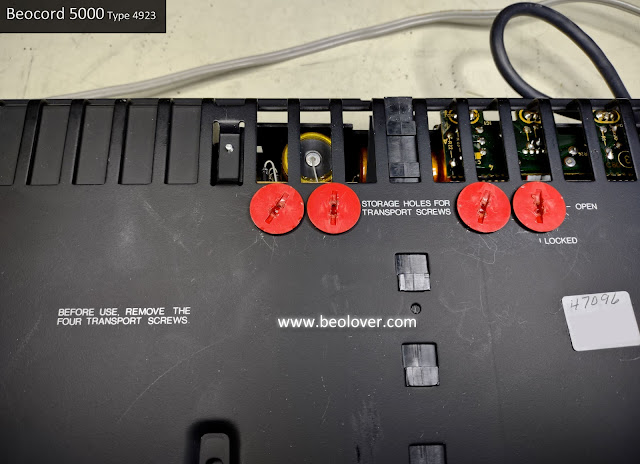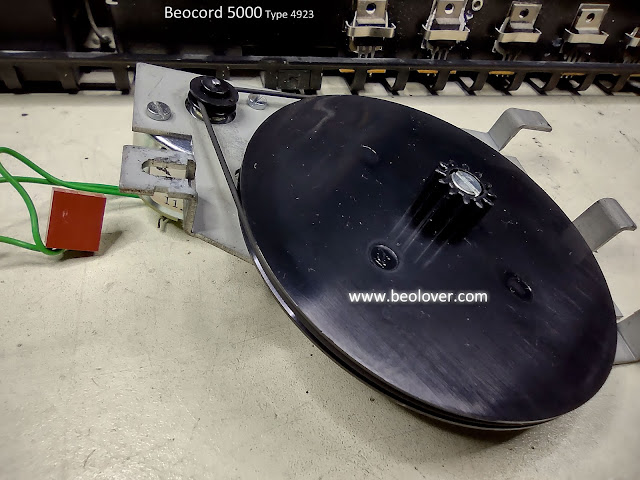Here is another companion to the Beomaster 5000 that I recently completed. Those components are of course part of a Beosystem 5000 produced by Bang & Olufsen in the mid-eighties.
This Beocord 5000 is the second cassette deck by Bang & Olufsen to carry that product name. The original Beocord 5000 was Type 47xx and produced in the late seventies. They are quite different but both very good cassette decks.
The sized and look of the Beocord 5000 Type 4923 matches the Beomaster 5000 Type 2323 and the CD50 Beosystem 5000 components. The displays and controls are accessible from the front and via a master remote control. The system audio components were designed so they could be neatly stacked on top of each other.
They all have a neat mechanical mechanism to remove the top cover for servicing.
Two screws at the back are loosened, slid upward, then re-tightened to release the cover.
Here is the Beocord with the cover removed.
On the bottom cover of the Beocord 5000 there are four plastic transport locks that secure the sliding cassette deck unit during shipment.
When the transport locks are removed the Beocord 5000 sliding chassis becomes operational.
As mentioned earlier, the Beosystem 5000 components were designed to be stackable.
For that reason the Beocord 5000 slides forward, out of the cabinet to reveal the controls and the cassette tray. There is a motor and belt in the Beocord 5000 specifically for moving the sliding chassis.
Like the other Beosystem 5000 components the Beocord has a service position design for technicians to work on the unit.
The first step in putting the Beocord 5000 into service position is to remove the cassette control area plastic panel. There are two plastic tabs on either side of the panel that are pressed in so the panel can be lifted up.
The panel is lifted off and a single cable is unplugged to get it out of the way.
The bright red, plastic clips shown need to be removed to release the main circuit board for servicing.
There are actually six plastic clips as the photo below shows that I already removed the first one.
After the plastic panel is removed there are two screws on either side of the Beocord front panel that will now be exposed. Those are removed to tilt the front display panel forward.
In addition, there are two metal rods that hold down the circuit board that need to be pulled from their lock positions (and tilted out of the way).
The front connector to the display panel needs to be disconnected.
Finally the main circuit board can be lifted up and put into a couple of slots on the side of the cabinet in the service position.
On the back side the two metal braces can be tilted forward and used to lock the main circuit board upright.
Now the cassette transport assembly can be removed and examined.
Not surprisingly, there is a broken belt. I am very relieved that the belts have not deteriorated into that gooey tar like state I have run into before. When that condition occurs it requires a lot of clean up.
This task will be just be to remove the old belts and install the brand new ones.
Here is the belt on the mechanism that opens and closes the Beocord 5000 sliding chassis.
I will replace that as well.
The owner of this Beocord 5000 purchased it new along with the other Beosystem 5000 components back in the eighties. The system has been well taken care of and I don't expect any unusual electrical issues so my plan for any electronic restoration work on this cassette deck is to just replace the electrolytic capacitors in the power supply. That is one area that has been a cause of failures after thirty-five years on some of these units.
I did't have those particular axial, electrolytic capacitors on hand so while they are on their way from Mouser Electronics I will start on cleaning the inside and replacing the belts.
















No comments:
Post a Comment
Comments and suggestions are welcome!